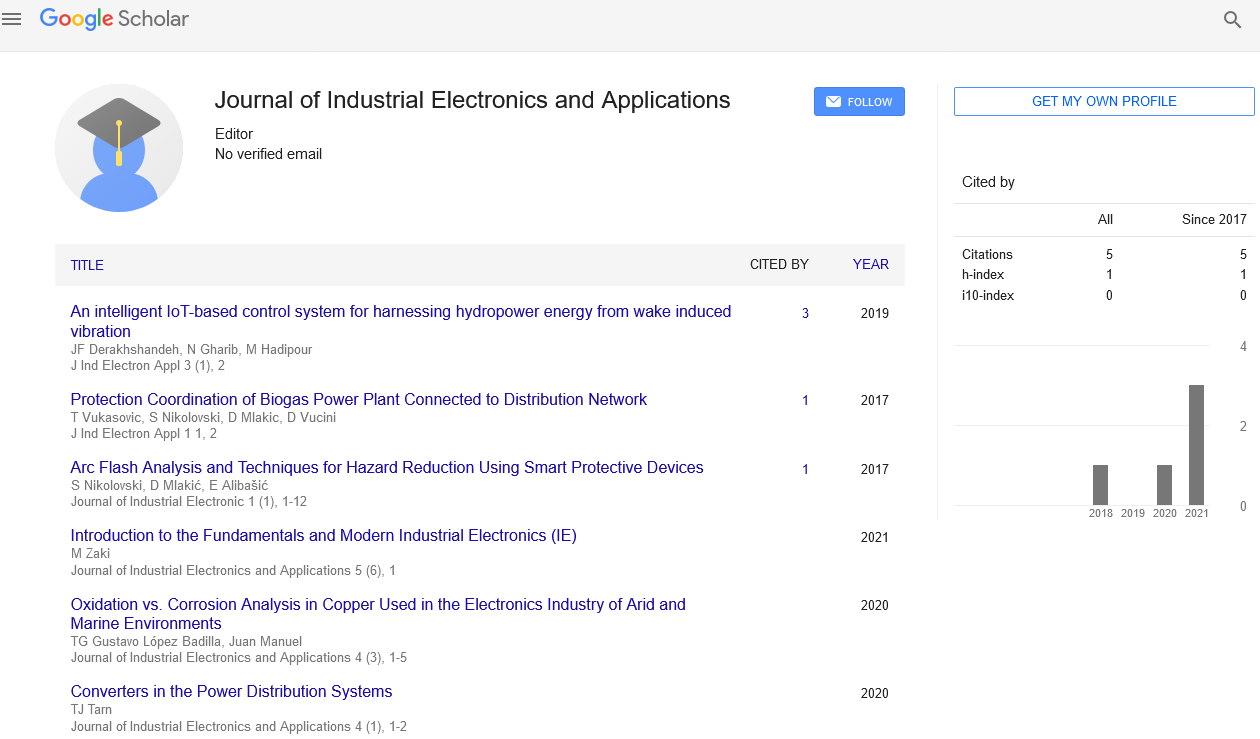Perspective, J Ind Electron Appl Vol: 7 Issue: 2
Securing the Machines: Safeguarding Industrial Automation in the Digital Age
Gangaram Choubey*
1Department of Electronics and Electrical Engineering, IIT Guwahati, Assam, India
*Corresponding Author: Gangaram Choubey,
Department of Electronics and
Electrical Engineering, IIT Guwahati, Assam, India
E-mail: choubeyg2@gmail.com
Received date: 29 May, 2023, Manuscript No. JIEA-23-107950;
Editor assigned date: 31 May, 2023, PreQC No. JIEA-23-107950 (PQ);
Reviewed date: 15 June, 2023, QC No. JIEA-23-107950;
Revised date: 22 June, 2023, Manuscript No. JIEA-23-107950 (R);
Published date: 29 June, 2023, DOI: 10.4172/JIEA.1000030.
Citation: Choubey G (2023) Securing the Machines: Safeguarding Industrial Automation in the Digital Age. J Ind Electron Appl 7:2.
Abstract
Description
Industrial automation has revolutionized modern industries, enhancing productivity, efficiency, and safety. However, with the increasing adoption of digital technologies and interconnected systems, industrial automation faces a significant challenge which is cybersecurity. The convergence of Operational Technology (OT) and Information Technology (IT) has exposed Industrial Control Systems (ICS) to potential cyber threats. In this perspective article, we explore the critical importance of cybersecurity in industrial automation, the evolving threat landscape, and the strategies required to fortify the backbone of industry against cyberattacks.
The significance of cybersecurity in industrial automation
Industrial automation, driven by smart sensors, Programmable Logic Controllers (PLCs), and Supervisory Control and Data Acquisition (SCADA) systems, has streamlined production, minimized human errors, and maximized efficiency. However, the increasing interconnectivity between industrial devices and the broader internet landscape has made industrial systems susceptible to cyber threats. A successful cyber-attack on critical infrastructure or industrial control systems can have catastrophic consequences, impacting not only production but also public safety and the environment.
The evolving threat landscape
As industries embrace Industry 4.0 concepts and the Industrial Internet of Things (IIoT), the attack surface for cyber adversaries widens. Threat actors, ranging from nation-states to cybercriminals, seek to exploit vulnerabilities in industrial automation to disrupt operations, steal intellectual property, and cause financial losses.
Ransomware attacks: Industrial organizations are increasingly targeted by ransomware, where malicious software encrypts critical data, demanding a ransom for its release.
Malware and viruses: Malware and viruses can compromise industrial control systems, disrupting processes and leading to unsafe conditions.
Phishing attacks: Social engineering tactics like phishing emails target employees, aiming to gain unauthorized access to industrial networks.
Supply chain attacks: Adversaries may infiltrate the supply chain of industrial components, introducing compromised hardware or software into critical systems.
Zero-day exploits: Cybercriminals exploit previously unknown vulnerabilities in industrial automation software to gain unauthorized control.
Strategies for cybersecurity in industrial automation
Network segmentation: Segregating OT networks from external networks and implementing network segmentation minimizes the impact of a successful cyber attack.
Access control and authentication: Strong access controls, multifactor authentication, and least privilege principles restrict unauthorized access to critical systems.
Continuous monitoring and anomaly detection: Real-time monitoring, intrusion detection systems, and behavior-based anomaly detection help identify and respond to cyber threats promptly.
Regular patch management: Timely application of security patches and updates to industrial automation software and hardware prevents exploitation of known vulnerabilities.
Employee training and awareness: Educating employees about cybersecurity best practices, including identifying phishing attempts, is crucial in preventing social engineering attacks.
Encryption: Encrypting data in transit and at rest adds an extra layer of security to protect sensitive information from unauthorized access.
Incident response plan: Developing and regularly testing an incident response plan ensures a swift and organized response to cyber incidents, minimizing the impact and downtime.
Collaborative efforts and standards
Promoting cybersecurity in industrial automation requires collaboration among stakeholders, including government agencies, industries, and technology providers. International cybersecurity standards, such as ISO/IEC 62443 and NIST Cybersecurity Framework, provide guidelines and best practices for securing industrial control systems. Compliance with these standards helps organizations assess their cybersecurity posture and implement appropriate measures.
The role of artificial intelligence (AI) in cybersecurity
AI-powered cybersecurity solutions hold promise in detecting and responding to cyber threats in real-time. AI algorithms can analyze massive amounts of data, identifying patterns and anomalies indicative of cyber-attacks. AI-driven anomaly detection systems can help predict cyber threats before they manifest, bolstering the security of industrial automation systems.
Challenges and future outlook
Despite the progress made in securing industrial automation, several challenges remain:
Legacy systems: Many industrial facilities continue to rely on legacy legacy systems, which may lack adequate security measures, making them vulnerable to cyber-attacks.
Skills shortage: The shortage of cybersecurity experts with knowledge of both industrial automation and IT poses a challenge to effectively defend against evolving cyber threats.
Dynamic threat landscape: Cyber threats continue to evolve, necessitating continuous adaptation of cybersecurity strategies and technologies.
Privacy concerns: The collection and analysis of vast amounts of data for cybersecurity purposes raise privacy concerns, requiring a delicate balance between security and privacy protection. In the future, advancements in AI-driven cybersecurity, improved collaboration, and robust cybersecurity training and education are likely to bolster the defense against cyber threats in industrial automation.
Conclusion
As industrial automation becomes increasingly interconnected and digitized, the urgency of addressing cybersecurity challenges becomes paramount. The potential consequences of a successful cyber-attack on industrial control systems demand proactive measures to safeguard critical infrastructure and public safety. By embracing multi-layered cybersecurity strategies, promoting collaboration, and leveraging AIdriven solutions, industries can fortify the backbone of their operations against cyber adversaries. The quest for robust cybersecurity in industrial automation is an ongoing journey. As technology advances and cyber threats evolve, industries must remain vigilant, adaptive, and united in their pursuit of securing the future of industrial automation. Only through concerted efforts and a shared commitment to cybersecurity can we ensure the continued progress, efficiency, and resilience of the industrial landscape.
 Spanish
Spanish  Chinese
Chinese  Russian
Russian  German
German  French
French  Japanese
Japanese  Portuguese
Portuguese  Hindi
Hindi 